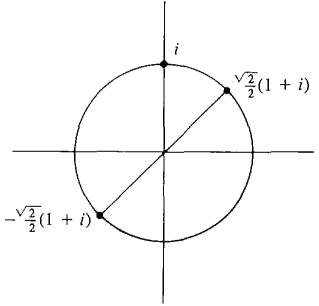| The ebook Elementary Calculus is based on material originally written by H.J. Keisler. For more information please read the copyright pages. |

|

Home  Differential Equations Differential Equations  Complex Numbers Complex Numbers  Examples Examples  Example 6 Example 6 |
|






|
|
Example 6
Find the square roots of i. By the computation in Example 3, the polar form of i is i = cis (π/2).
The two square roots of i are shown in Figure 14.5.4.
Figure 14.5.4 We now turn to complex exponents, which are useful in the study of differential equations. In order to give a meaning to an exponent e2, we consider infinite series of complex numbers. The sum of an infinite series of complex numbers is defined by summing the real and imaginary parts separately. If zn = xn + iyn, and the series ∑xn and ∑yn both converge, the sum of the series ∑zn is defined by the formula
In Chapter 9, we found that for real numbers z the exponent ez is given by the power series
When z is a complex number, this formula is taken as the definition of ez. It can be shown that the power series converges for every z and that the exponential rule eu+z = eu ez holds for complex exponents. In the case that z is a purely imaginary number z = iy, the power series takes the form
Using the power series for cos y and sin y, we obtain Euler's Formula: eiy = cos y + i sin y = cis y. When z is a complex number z = x + iy, the exponent ez is given by the formula gx + iy = ex eiy = ex(cos y + i sin y).
|
|
Home  Differential Equations Differential Equations  Complex Numbers Complex Numbers  Examples Examples  Example 6 Example 6 |
|
Last Update: 2006-11-16






